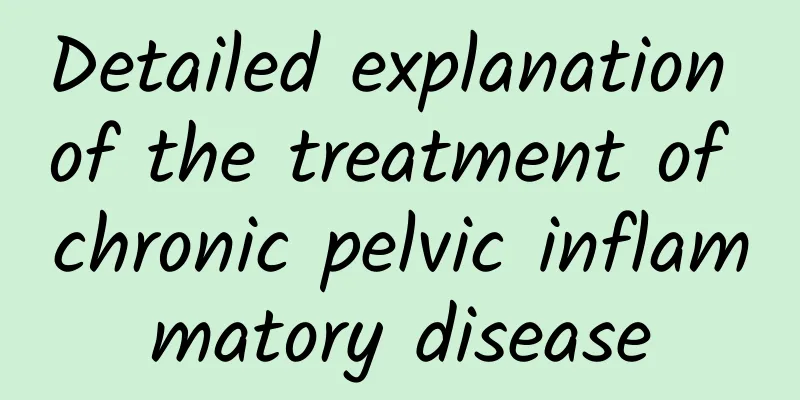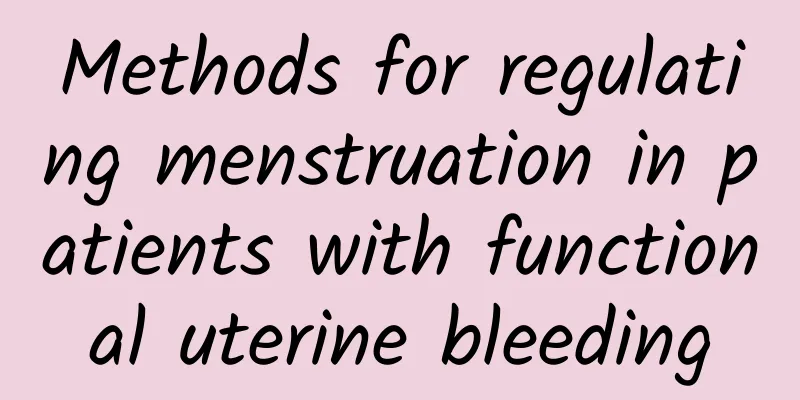Detailed explanation of the treatment of chronic pelvic inflammatory disease

|
Patients with chronic pelvic inflammatory disease must pay attention and receive active treatment. This is mainly due to the failure to thoroughly treat acute pelvic inflammatory disease or the patient's poor physical condition and prolonged course of the disease. It is easy to relapse and the harm to female patients is considerable. Therefore, active treatment is very important. Let's take a look at the detailed treatment methods of chronic pelvic inflammatory disease. 1. General treatment: Women should have confidence in treatment, and at the same time, they should also strengthen their nutrition, exercise, and be careful not to overwork, so as to improve the body's resistance and avoid recurrence of infection or the spread of infection. 2. Physical therapy: Warmth can promote local blood circulation in the pelvic cavity, improve the nutritional status of tissues, and increase metabolism, which is conducive to the absorption and disappearance of inflammation. At the same time, combined with relevant drug treatments, it can promote the body's absorption and utilization of drugs. Commonly used methods include short wave, ultrashort wave, microwave, laser, ion penetration, etc. 3. Antimicrobial drug treatment: Long-term or repeated combination therapy with multiple antibiotics sometimes has no significant therapeutic effect, but it can be used for young people who need to retain their reproductive function or for acute attacks. It is best to use anti-chlamydia or mycoplasma drugs at the same time. 4. Surgical treatment: Surgical treatment is suitable for some patients with chronic pelvic inflammatory disease. These patients suffer from adhesions around the female reproductive organs due to long-term inflammatory stimulation. At this time, anti-inflammatory drugs have no effect, so surgical treatment is more effective. Patients should pay attention to personal hygiene, prevent all kinds of infection, keep the perineum clean and dry, wash the vulva with clean water every night, and use a dedicated basin. Do not use your hands to wash the vagina, and do not use hot water or soap to wash the vulva. In addition, when suffering from pelvic inflammatory disease, the amount of leucorrhea is large and sticky, so you should change your underwear frequently and do not wear tight or synthetic underwear. Avoid sexual intercourse during sensitive periods. Avoid sexual intercourse during menstruation, after abortion, and after gynecological surgery such as placement and removal of IUDs. Avoid swimming, bathing in a tub, or taking a sauna. Change sanitary napkins frequently. The body's resistance is reduced during this period, and pathogens can easily enter and cause infection. Fever patients usually sweat more when the fever subsides. Pay attention to keeping warm and keep the body dry. Change clothes after sweating and avoid using air conditioning or direct convection wind. |
<<: The most effective treatment for vulvar leukoplakia
>>: What are the symptoms and treatment of adnexitis?
Recommend
What diseases are easily confused with pelvic inflammatory disease
So who are your girlfriends who have pelvic infla...
How to care after missed abortion
Speaking of missed abortion, many people may feel...
The World Championship Jiu-Jitsu team doctor shared: athletes' sports injury medication taboos, and experience in regaining weight after losing weight
Competition is fierce among athletes in internati...
Menstrual disorders and weight gain ~ To prevent polycystic ovary disease, you must first nourish your kidneys. This cup of tea is a good helper!
Does your period always come on time? Clinically,...
Three main reasons for recurrence of pelvic inflammatory disease
Pelvic inflammatory disease is a common female di...
What are the treatments for cervicitis?
Cervicitis is one of the common gynecological dis...
Let's take a look at the dietary taboos for uterine fibroids
It is important for patients with uterine fibroid...
Under what circumstances is it necessary to remove uterine fibroids? Under what circumstances is it necessary to remove the uterus?
Under what circumstances is it necessary to remov...
What is endometrial thickening?
Endometrial thickening is a common uterine diseas...
How can we prevent ovarian cysts?
How can we prevent ovarian cysts? Ovarian cysts a...
What are the dangers of untreated pelvic peritonitis to women?
Women all know what kind of disease pelvic perito...
Experts teach you how to treat vaginal candidal infection
With the continuous advancement of medical techno...
Precautions for patients with chronic adnexitis during the recovery period
At present, the incidence of chronic adnexitis in...
Will the uterus shrink during menopause? Is it normal for the uterus to shrink during menopause?
It is normal for the uterus to shrink during meno...
How to treat postmenopausal adenomyosis
Adenomyosis often occurs between the ages of 35 a...









